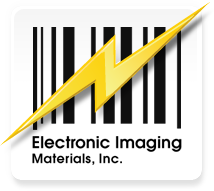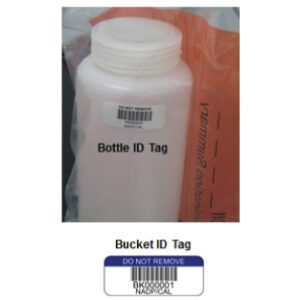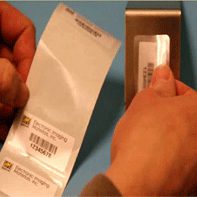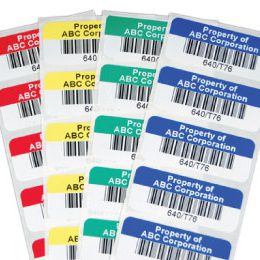When a standard label won’t do, customization becomes mission-critical.
Medical devices are becoming more advanced, more compact, and more uniquely shaped. As the devices evolve, so do the demands placed on their labels. A label that simply “sticks” is no longer enough. It must hold up under chemical exposure, flex with curved surfaces, and meet rigorous regulatory standards while remaining readable and scannable.
This is where custom label solutions come into play. For manufacturers working with specialized instruments or nontraditional designs, off-the-shelf options fail to deliver the precision, durability, or compliance required. If your product falls into the “complex” category, it’s time to think about how a smarter labeling approach can support your success.

Why Complex Devices Require Custom Labeling
Not every device is flat, consistently dry, or easy to label.
Modern devices, from concave handles to silicone housings and chemical exposure during sterilization, create labeling challenges that demand customization. Consider some of the most common complications:
Irregular Surfaces
Many advanced devices feature rounded, angled, or textured surfaces that cause traditional labels to buckle, lift, or fall off entirely. A curved surgical handle or miniature diagnostic tool requires flexible material and conformable adhesive that stays put over time.
Mixed or Non-Stick Materials
Medical-grade plastics, silicone, and coated metals often fail to bond well with general-purpose adhesives. Choosing the wrong label can mean wasted product or unreadable information during a critical procedure.
Exposure to Harsh Conditions
Autoclaving, refrigeration, and chemicals like xylene or ethanol require that your label remain intact. Unprotected labels degrade quickly in these environments, making material and adhesive selection essential.
Small Sizes, Big Requirements
Even tiny devices need to carry a lot of information, like UDI, model number, expiration date, and usage instructions. This creates a need for high-density printing, precise design, and thoughtful layout planning.
When you combine these challenges, you’re dealing with complex device labeling. That means you need more than a basic print-and-stick solution.
Designing Labels That Work: Form Factor Meets Function
Designing around the device is step one.
One of the most valuable parts of developing custom label solutions is matching the label to the unique shape and function of your product. That often means starting from the device itself.
At Electronic Imaging Materials, we’ve had customers send us physical samples, such as oddly shaped plastic enclosures, vials with tiny necks, or complex instrument clusters, so we can prototype labels that fit, flex, and function properly. Here’s what we look at:
Shape-Specific Engineering
For concave or irregular surfaces, we recommend wraparound labels using flexible materials and specially engineered adhesives that can contour without lifting. Some applications call for flag-style designs, tamper-evident seals, or edge-to-edge printing zones.
Material Compatibility
Certain adhesives are built to bond with low-surface-energy materials like polyethylene or silicone. Others are designed for exposure to moisture, chemicals, or high heat. Getting the pairing right ensures labels stay in place and function correctly when it matters most.
Layout and Print Strategy
Custom labels are cut to fit and designed to present information clearly, even when real estate is limited. Variable data like serial numbers, color indicators, or 2D barcodes must be legible at a glance and scannable every time.
The result is a label that integrates with your device in form and function.Multi-use devices require adhesives that go beyond basic bonding. They must endure repeated exposure to steam, disinfectants, and physical handling. This isn’t just a sticker. It’s a high-performance adhesive system designed for the medical field.
Choosing the right adhesive involves more than a quick compatibility check. You need to account for the device substrate, sterilization method, and surface texture. A label that looks great on paper won’t last five minutes in an autoclave if the adhesive isn’t engineered for it.
Whether your device is oddly shaped, frequently sterilized, or made from unconventional materials, Electronic Imaging Materials can deliver a label that fits and performs.
Tough Adhesion for Critical Applications
If the adhesive fails, the label fails.
This is especially true in healthcare settings, where custom medical device labels must perform without compromise. We tailor adhesive recommendations based on your exact use case, considering:
- Surface type and texture
- Contact with solvents or cleaning agents
- Exposure to heat, cold, or moisture
- Required removability or permanence
- IEC60601 marking requirements (we meet this level)
We use high-performance adhesives that grip tightly to curved or oily surfaces but will not damage sensitive materials. In lab environments, we often recommend laminated labels with chemical-resistant adhesive to protect against degradation during sterilization.
Labels Built to Satisfy Auditors
Labels are about more than durability. They support accountability.
Medical device regulations require labels to be clear, accurate, and traceable throughout the product lifecycle. A poorly designed label causes confusion and introduces risk. That is why custom medical labels are engineered with compliance in mind.
We help you align with:
- FDA Unique Device Identification (UDI) mandates
- ISO 15223-1 symbols and formatting
- IEC60601-1 standards for durability and readability
- Label permanence requirements through sterilization and handling
Need sample runs for validation? We support that. Testing prototypes is a standard part of our process, giving your team the opportunity to verify adhesion, scan quality, and layout in your real-world environment before full production.
Custom Label Solutions Built for the Job
The proof is in the performance. When off-the-shelf options fall short, custom label solutions provide practical answers to real-world challenges. These examples illustrate how tailored materials, adhesives, and designs can address the complex demands found in the medical device field.
Precision Labeling for a Micro Diagnostic Cartridge
This compact diagnostic device allowed less than half an inch of surface area for labeling but still needed to display a barcode, serial number, and use-by date. A high-density synthetic label was selected to deliver sharp, legible print in a tight space. Laser-printable stock ensured precision, while a curved adhesive offered a clean, permanent wrap. A protective laminate added durability, helping the label resist wear from repeated handling and use.
Adhering to Silicone on a Surgical Handle
Silicone surfaces are notoriously difficult to label due to their low surface energy. Standard adhesives typically fail, particularly under sterilization cycles. In this case, a specialty adhesive engineered specifically for silicone was paired with a flexible material capable of wrapping securely around the handle’s curve. The resulting label maintained adhesion and legibility, even after multiple autoclave runs.
Coordinated Label Sets for Multipiece Packaging
For a complex packaging system, the manufacturer required a master label for the outer carton, smaller component labels, and matching identifiers for paperwork. A coordinated labeling set was produced using variable data, ensuring all parts shared the same lot number and design language. This approach improved traceability, eliminated mismatches, and simplified the assembly and documentation process.
Partnering With Label Experts
You don’t have to be a labeling expert. That’s our role.
The best results come from collaboration between device engineers, quality teams, and label specialists. We support you every step of the way:
- Review drawings or physical samples
- Recommend materials, adhesives, and formats
- Prototype and test labels in real-world conditions
- Iterate based on feedback
- Move to full production with confidence
This is how high-performance custom label solutions are built.
Your Device Is Unique. Your Label Should Be Too.
Medical devices are pushing boundaries in shape, function, and precision. But when labeling is an afterthought, it risks undermining everything you’ve engineered. Labels must do more than stick. They need to work in sync with the device’s surface, withstand its environment, and pass regulatory audits.
Purpose-built custom label solutions support your success from the outside in:
Better Device Integration
A well-designed label becomes part of the product. Custom shapes, flexible materials, and form-fitting adhesives ensure your label wraps cleanly around curves, settles into recessed spaces, or holds firm on textured surfaces.
Stronger Regulatory Alignment
Labels play a major role in compliance, especially under standards like IEC60601-1. Custom solutions ensure required data is durable, legible, and positioned exactly as needed. You lower the risk of noncompliance and ease audit preparation.
Fewer Field Issues and Relabeling Headaches
Generic labels often fail under real-world conditions. They peel, smear, or fall off. That leads to downtime, costly relabeling, or failed inspections. Custom medical labels are built to withstand stress from sterilization, moisture, and handling, reducing disruptions and long-term costs.
A More Polished, Professional User Experience
An intentional label design elevates the perception of your product. Clean alignment, crisp print, and well-placed icons improve usability and make your brand appear as premium as your technology.
Let EIM Create Your Custom Label Solutions
At Electronic Imaging Materials, we specialize in custom medical device labels designed to handle real-world challenges. Our team helps you develop:
- Labels for small devices and irregular shapes
- Adhesives that hold firm under pressure
- Laminates that resist chemicals and sterilization
- Variable data print runs and matched sets
- Testing and prototyping workflows
- Labels that meet IEC60601-level durability requirements
There is no reason to settle for generic. With EIM, you receive purpose-built labeling that performs from concept to production.
Let’s create labels that work as hard as your device. Contact us today to begin your next labeling project with confidence.
Best Practices for Optimizing Label Performance
No matter which category your device falls into, following these best practices can significantly reduce labeling risks and enhance overall performance:
- Choose materials based on the actual environment they’ll face. Prioritize durability in the face of heat, chemicals, or moisture, not just price.
- Pay close attention to adhesives. They are vital to maintaining label integrity, especially under stress from sterilization or handling.
- Validate durability under realistic conditions. Simulated cleaning and sterilization cycles can reveal weaknesses before they reach the field.
- Make sure all barcodes and text remain readable under typical lighting conditions and scanning workflows.
- Be strategic about label placement. Avoid positioning on high-friction zones or tight curves that can cause peeling or distortion.
Labeling With Purpose, Built for Performance
Your label ensures compliance, protects patients, and keeps your supply chain flowing. And whether your product is used once or a hundred times, its label should support that mission.
Electronic Imaging Materials offers labels that go the distance. From rugged single-use device labels to advanced systems for reusable instruments, we offer:

Materials that resist sterilization, solvents, and abrasion

Adhesives tailored for your substrate and lifecycle

Barcode systems that support full traceability and compliance
> Reach out today and let’s build a labeling solution that works as hard as your device does.





